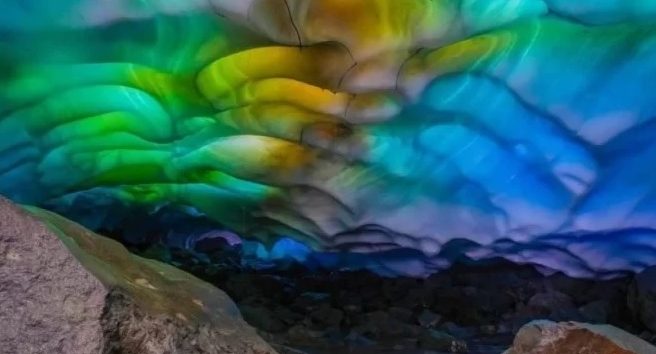Caves in the United States attract tourists for their beauty, but they are also dangerous
2 min read

Ber
Southern Newsroom
| September 7, 2022

“I didn’t enhance the colors in the pictures I’m going to share with you all! It was really colorful,” said the photographer.
Photo: Background/Instagram
“I didn’t enhance the colors in the pictures I’m going to share with you all! It was really colorful,” said the photographer. (Photo: Background/Instagram)
After a stunning photo of a rainbow-colored ice cave inside Mount Rainier Park went viral, the National Park Service (NPS) issued a warning: Ice caves may be beautiful, but they can be dangerous.
Nature photographer Matthew Nichols recently photographed the snow caves of Mount Rainier in Washington state, USA. When the sun hits the roof of these ice caves, the light is drawn back to the ceiling of the ice cave, creating a display of vibrant colors.
“I could not believe what my eyes saw. “I climbed Mt. Rainer specifically to explore the ice caves and never imagined they would be so colorful,” the photographer said in an Instagram post. “I didn’t enhance the colors in the pictures I’m going to share with you all! It was really colorful. “
The pictures went viral and were widely shared on various media platforms. However, the NPS cautions that as beautiful as ice caves are, it’s best to stay far away from them.
“For clarification, a photo of a channel of meltwater under perennial snow (snow that lasts through the summer),” the NPS said in a statement.
“Officials strongly discourage approaching or entering snow caves or meltwater channels because they are prone to involuntary collapse due to melting, which is accelerated this time of year. Collapsing or falling snow and rocks can be dangerous or cause serious injury to anyone walking into or near the entrance,” they continued. .
Future explorers are also at risk of developing hypothermia, they added, “due to a combination of cooler air temperatures in the interior and cooler meltwater flowing from the snowpack.”
The NPS notes that there were several known ice caves in Mount Rainier National Park, but warming temperatures in the 1980s forced them to close to the public. At lower elevations, especially during the warmer months, small car-sized chunks of ice have been known to fall into caves, sometimes with tragic results.
Elsewhere in Washington, collapsing ice caves have already proven deadly. In July 2015, one person was killed and five were injured when an ice cave section collapsed in the Mount Baker-Snoqualmie National Forest near Seattle.
Another accident occurred in the same caves in 2010 when an 11-year-old girl died in an avalanche.
come back
All tourism and tourism

“Communicator. Award-winning creator. Certified twitter geek. Music ninja. General web evangelist.”



:quality(80):focal(-5x-5:5x5)/cloudfront-us-east-1.images.arcpublishing.com/estadao/6LQDZFJQCBP4TJ4KSOTOFQH6KQ.jpg)